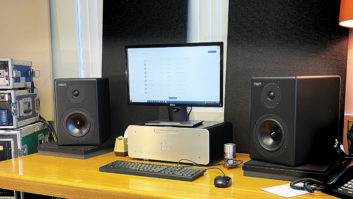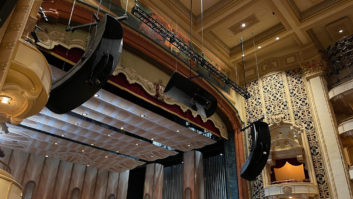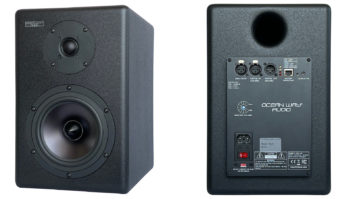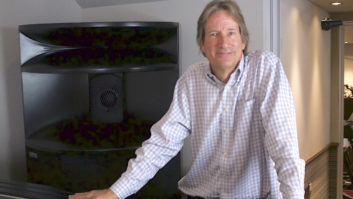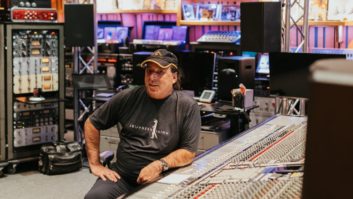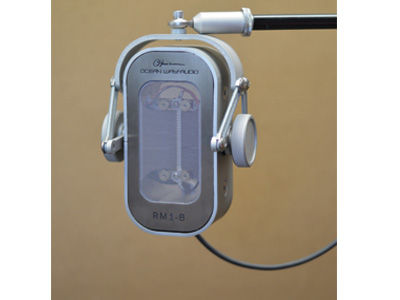
Ocean Way Audio’s RM1-B is the company’s latest iterationof Cliff Henricksen’s RM1 active,bi-directional ribbon microphone. The RM1-B has the RM1’smotor assembly witha 1.77-micron-thick aluminum ribbon. It usesa discretephantom-poweredpreamplifier designed toHenricksen’s specifications.
With the RM1-B, the RM1’souter peaked popfilter has been replaced witha single flat, woven Nylon-Spandex screen framed ina stainless steel frontplate. This frontplate is removable/replaceable as it’sheld inplace magneticallyby themotor assembly’s huge surrounding structure.
Looking likea smallmonitor speaker, theRM1-Bmeasures 15.24 cm tall, 7.62 cm wide and 5.08 cmdeep; it weighs 3.4 kilos, or about 7.5 pounds. It has an aluminum alloy body witha short, permanently attached XLR cable, and comes ina waterproof/airtight Pelican travel case. The RM1-B usesa gimbal-style yoke mount with large knurl knobson either side to tighten the mic’s body into any tilted position. The yoke is attached toa standard 5/8-inch threaded mic stand coupler usingahex screw that tended to come looseduringmy evaluations. The includedmount isnot a shockmount, but theoptional ISO1 ($170) boom shockmount is available. It usesreplaceableelastic suspension bands, andI wouldrecommend it.
Contributing in large part to the RM1-B’sheft is the massive magnet structure shaped like anelongated “O” with the inside sloping walls machined intoa magnetic waveguide that creates a focused magneticfluxdensityof 10,000 Gauss (1 Tesla unit)on both sidesof the ribbon.
The magnet waveguidegeometrydetermines the90-degree horizontal pickup pattern lobe for high-frequency capture starting at approximately 6.5 kHz and extending far beyond audibility (67 kHz theoretically). The verticalpickup pattern isdetermined by the ribbon’s 5cmheight, starting witha wide lobe at low/mid-frequencies and narrowing at 6.5 kHz untilby 13 kHz it becomes 45degrees wide.
RECORDING VOICE-OVER
I started witha voice-overrecording, andmy VO talent wanted to try the RM1-Bfirst.I used anywhere from 35 to 50 dBof mic gain fromaSunset Sound “Tutti”preamp. Even though I used about6 dBmore mic gain to matchrecording levels withamodern condenser mic, the RM1-B hadanoticeable lowernoisefloor.
With ribbon mics,a windscreen should always be used, and for anup-close dramaticreading,I usedmy Pete’s PlaceBlast Filter. There was the expectedproximity,but the sound wasopen anddetailed andnotoverlybright, with the extended high frequenciespleasing andnot harsh soundingor boosted.
Positioning the RM1-Bupright (recommended) in just the right spotrequired somerethinking/learning. If possible,I usedregular straight-upfloor stands for vocals or voiceover work.
The RM1-B’s large size, weight and the magnet’s attraction to steel stands, adapters,connectors, tools or anything ferrous can bea little problematicwhen dialing in an exactplacement. ButIgot used to pre-threading the mic to the boom endpiecefirst, and then attaching this toa heavy-duty stand/boom witha counter-weight andplacing sandbagson the base. Donot use quickrelease mic adapters with this mic.
ACOUSTICGUITAR/VOCAL
I recordeda Taylor 655C 12-stringacoustic guitar with the RM1-B placed about 30 cm out front and aimed at thebridge fora bright sound. With45 dB of preampgain and using no HPF asa starting point, thiswas just what the production needed;a touch of EQ/compression during the mix brought it home. The RM1-B provided good coverage of all thesound that instrument was projecting with pure detail and all subtle nuance. Just lovely!
For louder and harder playing,I moved the mic out to about 53cm to pull in more of the room’s ambience from the mic’s back lobe.I aimed at the 12th fret and used 40dB of gain. When playing softer andfingerpicking,I kept the same mic location butcranked up mic gain to 50dB.In both examples, the RM1-B produceda clear, balanced and vibrant sound with plenty of the acoustic space around the guitarincluded.
At another session fora vocal/acoustic guitar demo,Iusedthe RM1-B forthe singer andaRødeNTR ribbon (alsofigure-of-eight) onhis 12-string guitar.Ihadthe singer close in at about5 to 10cm. This produced some proximity, andIhad no problem with overloading with this experienced singer whoused appropriatemic technique forthe louder bits.I likedthe intimate soundthis microphone brought tothe singer’s performance.
ELECTRICGUITAR
NextI triedrecording both clean and distortedelectric guitar amp sounds. I usedmy FenderStratplugged intoa little 5-watt Class-A amp connected to a 12- inch speaker/cab.
Iuseda desktop stand and elevatedthe amp on an isolation platform. This allowed themic’s gimbal mount toswingthedirection ofthemic’s pickup up or downanywhere from straight onthe dust cover to any position onthe speaker’s cone. At no closer than 61cm fromthe grille cloth,the gimbal mount allowed fordialing inthe exact ratio of edge-to-tone soundmix.
The RM1-B revealed every detail—good and bad—about the amp’s sound. It is an honest and warm sound witha mellowing effect like older ribbon microphones produce. But the RM1-B has more accuracy, clarity and depth. This was an overdub, soI was free to move the mic furtheraway for less proximity and more of the rear lobe in the sound. ButI was careful not to get too close in and added the Blast Filter to prevent speaker chuffing or port air blasts from damaging or distorting the ribbon.
DRUMROOMMICS
I set upa pair of RM1-Bs asa Blumlein coincidence stereo pair array.I wanted tocapture an ambient-realistic recording ofa drum kit positioned at one end ofalarge drum recording room. The drum kit projected sound lengthwise down the room’s 7.7-meter length. (The roomis 3.5 meters high and 6.4 meters wide.) Mylaser-measuring deviceindicated that the Blumlein pair was positioned 3.34 meters outin front of the kit and centered within the room’s width.
I used two stands so that the bottom RM1-B was 1.41meters above thefloor with the second boom standholding theupper RM1-B so that it wasnearly touching the topof the bottom mic. Both mics were turned 90degrees (right angles) from eachother so that bothof the mic’s front sides were aimed left and right towards the drum kit. It took some time toget the two mics positioned—that’s 15 pounds of microphones—so they didn’t magnetically “stick” to eachother.
Listening to the pair panned L/R in an audience’s perspective,I could easilyhear the left side of the kit—ride cymbal, crash and floor tom—and the right side with rack tom, crash and hi-hat cymbals easily located andheard in the stereofield. The transients were clearbutnot harsh, and the cymbals were in balance relative to therestof the kit.This setup produced one of the best room sounds I’ve ever heard.I gota complete drum sound with loads of low frequencies—much more than using a condenser. The 24-inch kick sounded like it did in the room, and the toms and snare were all in balance and present.

There wasa slight tendency toward a “boxy”flavor,but when mixed with the close drum mics, itproduced a veryor- ganic overall drum sound. The RM1-B wasremarkably true to the source, asmy drummer, kit androom were top-notch.
The company cautions: “excellent for just about any instrument exceptnearfield kick drum andnear-field bass guitar speaker pickup (LF will harm the ribbon).” I quickly found this true for two RM1-Bs asoverhead mics located about 1.5 meters abovea drum kit—the toms and kickoverloaded the ribbon.
I was impressed by the ultra-realistic capture provided by Ocean Way Audio’s RM1-B Active Ribbon microphone.It is excellent for instruments or vocals—close in for medium to soft sources or for the ambient pickup of distant loud instruments such as drum kits or guitar/bass cabinets.
PRODUCTSUMMARY
COMPANY: Ocean Way Audio PRODUCT: RM1-B Active Ribbon Microphone
WEB: oceanwayaudio.com
PRICE: $2,600 MSRP
PROS: Silky, realistic and rich-sounding
CONS: Heavy and a little unwieldy to set up
TRY THIS
Foracousticguitarandvocal recording,Iarranged themics sothatthe side null oftheRM1-Bvocal micwas aimed attheside null oftheRøde NTRIused ontheacousticguitar. Theside nulls ofthetwofigure-of-eightmics workingtogether produces anamazingamount oftotalisolation! Soloingeither theguitarorthevocal, Icould barely heartheguitarleakage intotheRM1-Bandminimalvocal leakageintotheRøde.
